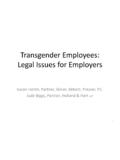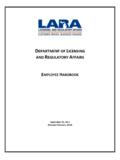Transcription of Guiding an Employer through the FMLA Leave …
1 Guiding an Employer through the fmla Leave Process You represent a growing private Employer one that has just hired its 50th employee. Now your growing client is seeking your guidance on complying with the Family and Medical Leave Act ( fmla ). Although administering fmla Leave , particularly intermittent fmla Leave , can be challenging, employers and their counsel who regularly use helpful compliance tools increase their chances of effectively managing fmla Leave issues. Helpful Tools that Provide fmla Guidance to employers Need Time? The Employee s Guide to the Family and Medical Leave Act The Wage & Hour Division of the Department of Labor (DOL) has recently published this 16-page, plain language booklet designed to answer common fmla questions and clarify who can take fmla Leave and what protections the fmla provides.
2 While the booklet was designed for employees, the publication can be helpful to employers in several ways. First, the guide provides a fairly easy to understand explanation of the how the fmla works and can be used by employers to help answer the questions of employees seeking Leave . Significantly, employees are more likely to accept an Employer s explanation of a document and the process and obligations it outlines when it contains the DOL seal on the front of it. Secondly, since many of the problems associated with administering the 2 fmla arise out of poor communication between the employee on Leave or seeking Leave and the Employer , dissemination of the guide to employees may help foster information sharing that will minimize unnecessary surprises.
3 A number of DOL drafted forms and notices that are appendices to the fmla regulations. A working familiarity with these documents and their contents will help employers administer fmla Leave from the time an employee provides notice of the need for fmla Leave through the employee s return to work. fmla FORMS AND NOTICES Document Purpose Employee Rights and Responsibilities Under the Family and Medical Leave Act Explains the fmla s provisions and provides information concerning the procedures for filing complaints of violations of the fmla with the DOL s Wage and Hour Division. Also helps employers satisfy their general notice obligations. Notice of Eligibility and Rights & Responsibilities (1) To notify an employee whether he or she is eligible for fmla Leave ; (2) when an employee is eligible for fmla Leave , to notify the employee of his or her rights and responsibilities for taking fmla Leave .
4 Certification Forms Suitable to use in order to determine whether an eligible employee is actually qualified for fmla Leave . The 4 different fmla certification forms and the basis for providing the applicable form to an employee is set out below (see fmla Certification Forms). Designation Notice Once an employee has completed the appropriate certification form, an Employer should use the Designation Notice to: (1) approve the fmla Leave request; (2) obtain additional information; or (3) deny the fmla Leave request. This guide is designed to help employers : o Know their notice obligations; o Recognize when an employee gives notice of the need for fmla Leave ; o Respond to an employee s request for Leave or notice of the need for fmla Leave ; o Evaluate an employee s certification and complete the Designation Notice; o Communicate with employees who are on Leave ; and o Anticipate and address an employee s return to work following fmla Leave .
5 3 Employer Notice The Employer has two general notice obligations under 29 The Employer is required to: A) Post and keep posted on its premises, in conspicuous places where employees are employed, a notice explaining the fmla s provisions and providing information concerning the procedures for filing complaints of violations of the fmla with the Department of Labor s (DOL s) Wage and Hour Division; B) Provide general notice to each employee. This can be accomplished through a policy in an employee handbook or by providing each employee with a copy the DOL s one-page document, Employee Rights and Responsibilities Under the Family and Medical Leave Act. In either case, distribution may be accomplished electronically.
6 Recognizing when an employee gives notice of the need for fmla Leave Employees have the responsibility of providing notice of the need for fmla Leave to the Employer . 29 (b). However, it is the Employer s responsibility to designate Leave as fmla -qualifying once it has acquired knowledge that Leave is being taken for an fmla -qualifying reason. 29 (a). Recognizing when an employee gives sufficient notice of the need for fmla Leave can be difficult. Unfortunately, even if an Employer unintentionally fails to designate fmla -qualifying absences as protected absences, it runs the risk of violating the fmla s interference clause. This is because a termination or any other negative employment action based only in part on an absence covered by the fmla may violate the fmla .
7 29 (c). employers and their counsel can use the Need Time? booklet to help supervisors and Human Resources representatives recognize potentially fmla -qualifying absences. Pages 4 & 5 of that booklet answers the question: When Can I Use fmla Leave ? These pages summarize the various fmla Leave entitlements, including: the serious health condition of the employee or covered family member; Leave for a birth, adoption, or foster care placement; and military family Leave . Before disseminating the Need Time? booklet, employers should designate a person or certain group of people to provide guidance to supervisors in determining whether an absence for a health condition or other potentially covered reason qualifies for fmla protection.
8 Once the person or group is tasked with that responsibility, other employees should be notified about the role of these representatives and provided with their contact information. Employees can make the Employer s duty of designating Leave as fmla -qualifying easier by explicitly requesting fmla Leave when they want it by completing a Leave of absence request form. Unfortunately, the fmla regulations expressly provide that an employee giving notice of the need for fmla Leave does not need to expressly assert rights under the Act or even mention the fmla to meet his or her obligation to provide notice of the need for fmla -qualifying Leave . 29 (b). Thus, a Leave of absence form cannot be required as a condition precedent to taking fmla Leave .
9 Additionally, a Leave of 4 absence request form is not likely to be completed by employees who take unforeseeable Leave . Consequently, supervisors should be cautioned against relying too heavily on completed Leave of absence request forms when determining whether an employee has provided notice of his or her need for fmla Leave . Because it is fairly common for supervisors to fail to properly recognize when an employee has given sufficient notice of the need for fmla Leave , several practices should be considered to help guard against unintentional interference with an employee s fmla rights: a. When an employee calls in sick, his or her supervisor should document exactly what they are told.
10 In other words, if an employee calls in and says, "I have pneumonia and will be going to the doctor today, but I think I'll be out this entire week," the supervisor should not document this as "sick." Instead, the supervisor should write down precisely what he or she was told by the employee. Alternatively, if the supervisor is permitted to summarize what the employee said, the summary should be complete. For example, the following would be acceptable: "Pneumonia - seeing doctor today - possibly out for entire week." b. Before a fmla eligible employee is either disciplined or reviewed unfavorably because of poor attendance, someone who has been trained on fmla compliance should review the employee s attendance record.

